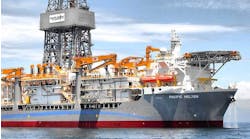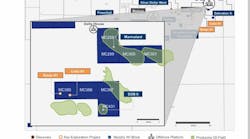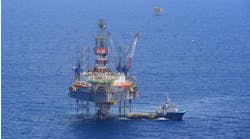Offshore staff
LONDON -- Primeline Energy Holdings has completed its initial review of data from its recent LS35-3-1 exploration well in the East China Sea.
The well in block 25/34 confirmed a hydrocarbon accumulation in the western flank of the Lishui basin. It flowed gas from a low-permeability reservoir, with significant implications, according to Primeline, for development of the deeper gas zones in the LS36-1 gas field and gas potential elsewhere in the region.
The company is working with CNOOC on a rolling development exploration program that aims to find additional reserves which could be tied into a proposed production facility at the LS 36-1 field.
This latest well was designed to test three potential stacked channel sand reservoirs, Targets 1, 2 and 3, over an anticipated depth range of 2,100-2,880 m (6,890-9,449 ft). Target 1 was prognosed to be similar in quality to the reservoir sequence in the LS36-1 gas field, which Primeline and CNOOC currently are developing.
Targets 2 and 3 were forecast to be similar to the lower gas sands in the LS36-1 gas field. All three reservoir targets also had bright spot and AVO characteristics similar to those seen on LS36-1, and the latest well intersected all three sands. Target 1, however, was water bearing while Target 2 had some gas, but mainly water.
Target 3, on the other hand, had gas from top to base of the reservoir. During testing, gas flowed naturally to the surface from the upper zone and was flared continuously for seven hours. Accurate measurement of the flow was not possible due to low wellhead pressure, but calculations on the differential pressure across the choke indicate a low flow rate. A second flow started after an 18-hour shut-in was halted due to formation sand clogging the main downhole valve on the test equipment.
Analysis of the well’s gas samples revealed low inert gas content (N, CO2) of 1.5-3.3% and a similar hydrocarbon composition to the LS36-1 field but with more liquid hydrocarbon content.
Primeline says that demonstrating that hydrocarbons are present on the western flank of the Lishui basin supports its hydrocarbon source generation and migration model. The low CO2levels also confirm its view that the CO2 present at LS36-1 is a result of localized and late CO2 generation in isolated areas, and that CO2 is not regionally present throughout the basin.
Achieving gas flow from the deeper low permeability reservoir was encouraging, the company adds, but the commercial potential of this latest well will depend on fracing and other optimization techniques to improve production rates. Primeline and CNOOC plan to test some of these concepts early in the LS36-1 development drilling program.
Flowing gas at reasonable rates from these deeper, tighter reservoirs could turn some of the gas-in-place in the lower sands at the LS36-1 gas field into producible reserves. This would also improve the economics of the development as production would be through the same infrastructure, the cost of which will be financed by production from the upper zone.
Additionally, the gas encountered in the latest well could be commercial if the fracing proves successful, with a tie-in distance of just 14.5 km (9 mi) to the proposed LS36-1 platform.
09/14/2010


